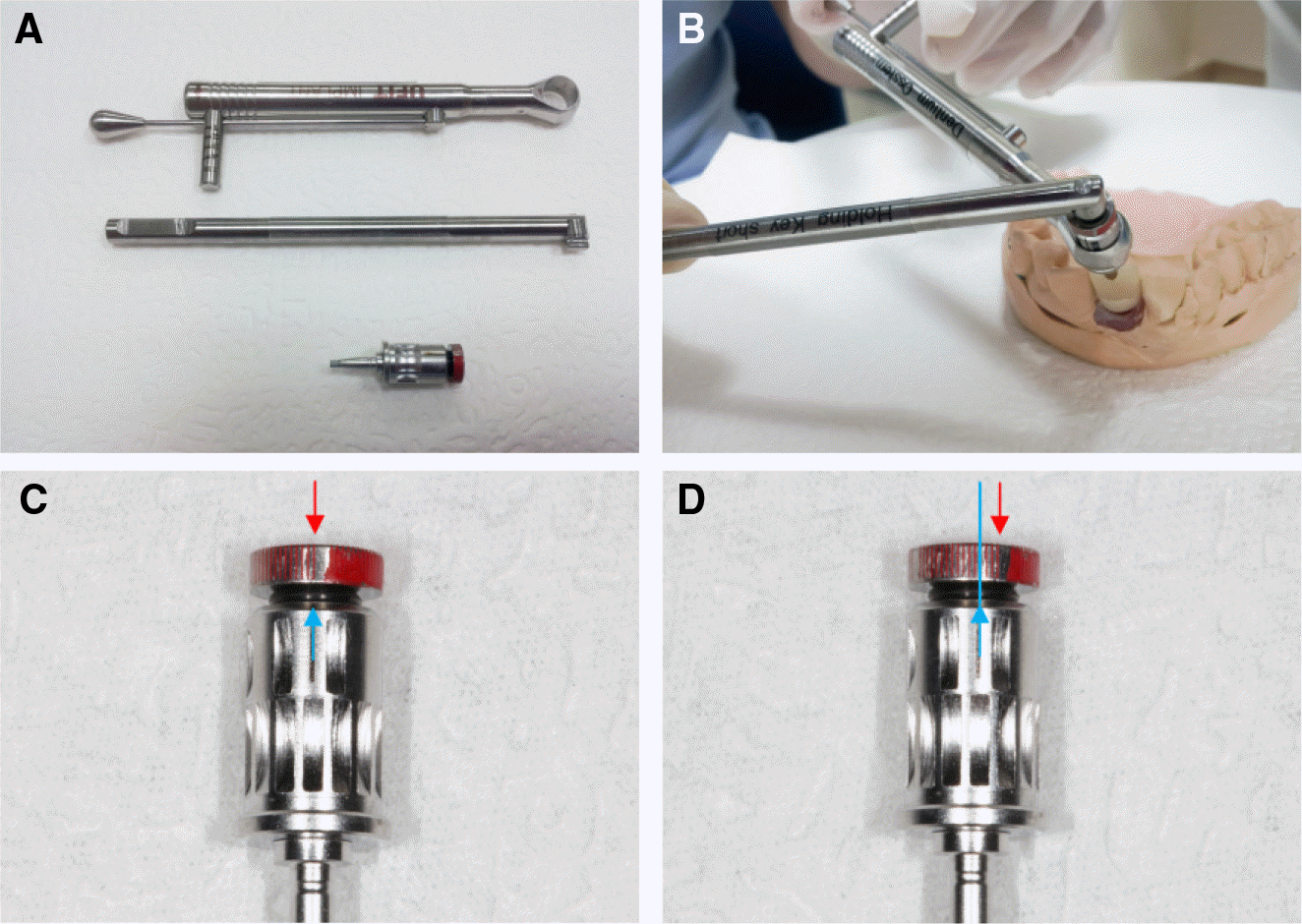Abstract
Purpose
The aim of this study was to investigate the effects of grooved abutments on abutment screw loosening.
Materials and methods
This study was conducted to evaluate the abutment screw loosening after 6 months for 50 patients (51 implants) treated at the department of Prosthodontics in Yonsei University Dental Hospital from March, 2015 to July, 2015. A control group with non-grooved abutment consists of 30 implants, and an experimental group with grooved abutment consists of 21 implants. Astra, Straumann, Implantium, Osstem system were used in the study. The abutments with loose screws cases after a period of 6 months has been investigated, with two kinds of measurements: 1) measuring the additional rotational angle on abutment during placement with the same force, 2) measuring the PTV on bucco-cervical area of implant crown. All data collected has been analyzed by normality test followed by Mann-Whitney test using SPSS program.
Results
No complications were reported after 6 months for the 51 implants. Abutment screw loose and crown fracture have not been seen in the study groups. The data collected from the two measurements showed no significant differences between the two groups with P-value 0.576 (average= control group: 7.35°, experimental group: 4.75°) for the additional rotational angle measurement and with P-value 0.767 for PTV.
Conclusion
There are no significant differences between the grooved and non-grooved abutment in screw stability. However, further studies with long-term followups and larger group of patients is needed in order to investigate the effects of grooved abutment on screw stability. (J Korean Acad Prosthodont 2016;54:387-92)
Go to : 
REFERENCES
1.Wittneben JG., Buser D., Salvi GE., Bärgin W., Hicklin S., Brägger U. Complication and failure rates with implant-supported fixed dental prostheses and single crowns: a 10-year retrospective study. Clin Implant Dent Relat Res. 2014. 16:356–64.

2.Jung RE., Pjetursson BE., Glauser R., Zembic A., Zwahlen M., Lang NP. A systematic review of the 5-year survival and complication rates of implant-supported single crowns. Clin Oral Implants Res. 2008. 19:119–30.

3.Dierens M., De Bruyn H., Kisch J., Nilner K., Cosyn J., Vandeweghe S. Prosthetic survival and complication rate of single implant treatment in the periodontally healthy patient after 16 to 22 years of follow-up. Clin Implant Dent Relat Res. 2016. 18:117–28.

4.Cha HS., Kim YS., Jeon JH., Lee JH. Cumulative survival rate and complication rates of single-tooth implant; focused on the coronal fracture of fixture in the internal connection implant. J Oral Rehabil. 2013. 40:595–602.

5.Pjetursson BE., Brägger U., Lang NP., Zwahlen M. Comparison of survival and complication rates of tooth-supported fixed dental prostheses (FDPs) and implant-supported FDPs and single crowns (SCs). Clin Oral Implants Res. 2007. 18:97–113.

6.Kim ES., Shin SY. Influence of the implant abutment types and the dynamic loading on initial screw loosening. J Adv Prosthodont. 2013. 5:21–8.

7.Gehrke P., Dhom G., Brunner J., Wolf D., Degidi M., Piattelli A. Zirconium implant abutments: fracture strength and influence of cyclic loading on retaining-screw loosening. Quintessence Int. 2006. 37:19–26.
8.Kitagawa T., Tanimoto Y., Odaki M., Nemoto K., Aida M. Influence of implant/abutment joint designs on abutment screw loosening in a dental implant system. J Biomed Mater Res B Appl Biomater. 2005. 75:457–63.

9.Kim SK., Lee JB., Koak JY., Heo SJ., Lee KR., Cho LR., Lee SS. An abutment screw loosening study of a Diamond Like Carbon-coated CP titanium implant. J Oral Rehabil. 2005. 32:346–50.

10.Bakaeen LG., Winkler S., Neff PA. The effect of implant diameter, restoration design, and occlusal table variations on screw loosening of posterior single-tooth implant restorations. J Oral Implantol. 2001. 27:63–72.

11.Dixon DL., Breeding LC., Sadler JP., McKay ML. Comparison of screw loosening, rotation, and deflection among three implant designs. J Prosthet Dent. 1995. 74:270–8.

12.Siamos G., Winkler S., Boberick KG. Relationship between implant preload and screw loosening on implant-supported prostheses. J Oral Implantol. 2002. 28:67–73.
13.Jörnéus L., Jemt T., Carlsson L. Loads and designs of screw joints for single crowns supported by osseointegrated implants. Int J Oral Maxillofac Implants. 1992. 7:353–9.
14.Zhou JF., Gu BQ., Chen Y. An improved design of spiral groove mechanical seal. Chinese J Chem Eng. 2007. 15:499–506.

15.Byrne D., Jacobs S., O'Connell B., Houston F., Claffey N. Preloads generated with repeated tightening in three types of screws used in dental implant assemblies. J Prosthodont. 2006. 15:164–71.

16.Coelho PG., Sudack P., Suzuki M., Kurtz KS., Romanos GE., Silva NR. In vitro evaluation of the implant abutment connection sealing capability of different implant systems. J Oral Rehabil. 2008. 35:917–24.
Go to : 
 | Fig. 2.Additional rotation measurement device. (A) Device set, (B) Device setting example, (C) Devices arrange state before measuring, (D) 3 clicks rotation state after measuring. |




 PDF
PDF ePub
ePub Citation
Citation Print
Print



 XML Download
XML Download